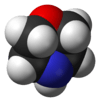Morpholine
| |||
| |||
| Names | |||
|---|---|---|---|
| Preferred IUPAC name
Morpholine | |||
| Other names
Diethylenimide oxide 1,4-Oxazinane Tetrahydro-1,4-oxazine Diethylene imidoxide Diethylene oximide Tetrahydro-p-oxazine | |||
| Identifiers | |||
| 3D model (JSmol) |
|||
| ChEBI | |||
| ChemSpider | |||
| ECHA InfoCard | 100.003.469 | ||
| KEGG | |||
| RTECS number | QD6475000 | ||
| UNII | |||
| |||
| |||
| Properties | |||
| C4H9NO | |||
| Molar mass | 87.12 g·mol−1 | ||
| Appearance | Colorless liquid | ||
| Odor | Weak ammonia-like or fish-like[2] | ||
| Density | 1.007 g/cm3 | ||
| Melting point | −5 °C (23 °F; 268 K) | ||
| Boiling point | 129 °C (264 °F; 402 K) | ||
| miscible | |||
| Vapor pressure | 6 mmHg (20 °C)[2] | ||
| Acidity (pKa) | 8.36[3] (of conjugate acid) | ||
| -55.0·10−6 cm3/mol | |||
| Hazards | |||
| Main hazards | Flammable, Corrosive | ||
| Safety data sheet | hazard.com | ||
| R-phrases (outdated) | R10 R20/21/22 R34 | ||
| S-phrases (outdated) | (S1/2) S23 S36 S45 | ||
| NFPA 704 | |||
| Flash point | 31 °C (88 °F; 304 K) | ||
| 275 °C (527 °F; 548 K) | |||
| Explosive limits | 1.4%–11.2%[2] | ||
| Lethal dose or concentration (LD, LC): | |||
| LD50 (median dose) |
1220 mg/kg (mammal, oral) 525 mg/kg (mouse, oral) 1050 mg/kg (rat, oral)[4] | ||
| LC50 (median concentration) |
365 ppm (mouse, 2 hr)[4] | ||
| US health exposure limits (NIOSH): | |||
| PEL (Permissible) |
TWA 20 ppm (70 mg/m3) [skin][2] | ||
| REL (Recommended) |
TWA 20 ppm (70 mg/m3) ST 30 ppm (105 mg/m3) [skin][2] | ||
| IDLH (Immediate danger) |
1400 ppm[2] | ||
| Except where otherwise noted, data are given for materials in their standard state (at 25 °C [77 °F], 100 kPa). | |||
| | |||
| Infobox references | |||
Morpholine is an organic chemical compound having the chemical formula O(CH2CH2)2NH. This heterocycle features both amine and ether functional groups. Because of the amine, morpholine is a base; its conjugate acid is called morpholinium. For example, treating morpholine with hydrochloric acid makes the salt morpholinium chloride.
Production
Morpholine may be produced by the dehydration of diethanolamine with sulfuric acid:[5]
Uses
Industrial applications
Morpholine is a common additive, in parts per million concentrations, for pH adjustment in both fossil fuel and nuclear power plant steam systems. Morpholine is used because its volatility is about the same as water, so once it is added to the water, its concentration becomes distributed rather evenly in both the water and steam phases. Its pH-adjusting qualities then become distributed throughout the steam plant to provide corrosion protection. Morpholine is often used in conjunction with low concentrations of hydrazine or ammonia to provide a comprehensive all-volatile treatment chemistry for corrosion protection for the steam systems of such plants. Morpholine decomposes reasonably slowly in the absence of oxygen at the high temperatures and pressures in these steam systems.
Organic synthesis
Morpholine undergoes most chemical reactions typical for other secondary amines, though the presence of the ether oxygen withdraws electron density from the nitrogen, rendering it less nucleophilic (and less basic) than structurally similar secondary amines such as piperidine. For this reason, it forms a stable chloramine (CAS#23328-69-0).[6]
It is commonly used to generate enamines.[7]
Morpholine is widely used in organic synthesis. For example, it is a building block in the preparation of the antibiotic linezolid, the anticancer agent gefitinib (Iressa) and the analgesic dextromoramide.
In research and in industry, the low cost and polarity of morpholine lead to its common use as a solvent for chemical reactions.
Producers
Most (as above) is widespread in Europe and the USA; accordingly, producers in Europe and the USA are able to cover the domestic and export markets.
Agriculture
As a fruit coating
Morpholine is used as a chemical emulsifier in the process of waxing fruit. Naturally, fruits make waxes to protect against insects and fungal contamination, but this can be lost as the fruit is cleaned. A small amount of new wax is applied to replace it. Morpholine is used as an emulsifier and solubility aid for shellac, which is used as a wax for fruit coating.[8] The European Union has forbidden the use of morpholine in fruit coating.[9][10]
As a component in fungicides
Morpholine derivatives used as agricultural fungicides in cereals are known as ergosterol biosynthesis inhibitors.
See also
References
- ↑ National Institute for Occupational Safety and Health (2000). "Morpholine". International Chemical Safety Cards. Retrieved 5 November 2005.
- 1 2 3 4 5 6 "NIOSH Pocket Guide to Chemical Hazards #0437". National Institute for Occupational Safety and Health (NIOSH).
- ↑ Hall, H. K. (1957). J. Am. Chem. Soc. 79 (20): 5441. doi:10.1021/ja01577a030. Missing or empty
|title=(help) - 1 2 "Morpholine". Immediately Dangerous to Life and Health. National Institute for Occupational Safety and Health (NIOSH).
- ↑ Weissermel, Klaus; Arpe, Hans-Jürgen; Lindley, Charlet R.; Hawkins, Stephen (2003). "Chapter 7. Oxidation Products of Ethylene". Industrial Organic Chemistry. Wiley-VCH. pp. 159–161. ISBN 3-527-30578-5.
- ↑ Lindsay Smith, J. R.; McKeer, L. C.; Taylor, J. M. (1993). "4-Chlorination of Electron-Rich Benzenoid Compounds: 2,4-Dichloromethoxybenzene". Org. Synth.; Coll. Vol., 8, p. 167
- ↑ Noyori, R.; Yokoyama, K.; Hayakawa, Y. (1988). "Cyclopentenones from α,α′-Dibromoketones and Enamines: 2,5-Dimethyl-3-Phenyl-2-Cyclopenten-1-one". Org. Synth.; Coll. Vol., 6, p. 520
- ↑ McGuire, Raymond G.; Dimitroglou, Dimitrios A. (1999). "Evaluation of Shellac and Sucrose Ester Fruit Coating Formulations that Support Biological Control of Post-harvest Grapefruit Decay". Bio-control Science and Technology. 9 (1): 53–65.
- ↑ "Morpholine". Scientific Analysis Laboratories Ltd.
- ↑ "Morpholine Issues in the United Kingdom". Northwest Horticultural Council. September 28, 2010.





